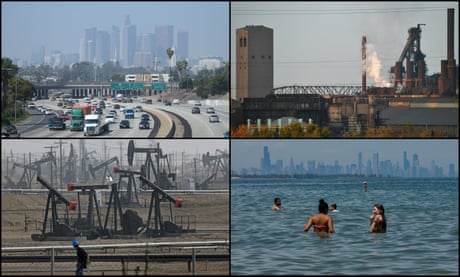- by foxnews
- 03 Feb 2025
Revealed: the 10 worst places to live in US for air pollution
Revealed: the 10 worst places to live in US for air pollution
- by theguardian
- 09 Mar 2023
- in news

The worst 10 hotspots for fine particle air pollution in the US have been revealed by The Guardian in an analysis using cutting-edge modelling.
The fine particles of air pollution emitted by cars, factories, wildfires and dusty agricultural activities, known to researchers as PM2.5, are small enough to travel deep into the lungs and into the bloodstream, increasing death rates from causes like respiratory disease, heart attacks and strokes. New research is showing they are associated with a surprising array of health impacts, ranging from miscarriages and Covid-19 to kidney damage and blood infections.
This top 10 is based on data recorded between 2011 and 2015, the most recent years available for the national model. The age of the data is typical for current air pollution studies performed by academics. Researchers say pollution patterns tend to remain relatively steady over the years.
While some of these intercity communities have since gentrified, the hotspot data shows the areas with the most air pollution are still the ones that faced redlining and real estate discrimination so many decades ago. Overall, they are 68% Black and only 25% white.
Another cluster of polluted census tracts borders the Atlanta airport, which ranks as the busiest air terminal in the world. Black people also make up the largest racial group in these areas.
The air pollution epicenters in this central Pennsylvania region differ from others around the nation. Instead of urban agglomerations, they are more like freckles scattered across the land.
Overall, the populations in neighborhoods with the highest PM2.5 levels were 52% Black, compared to 22% for other areas of the same counties.
Environmentalist Robert Bullard was not surprised that central Houston lies in a cloud of pollution. The college where he teaches, Texas Southern University, sits in the middle of it.
In the most polluted census tracts in Houston, 80% of residents are people of color.
Bullard, known as a founding father of the environmental justice movement, has documented in 18 books how neighborhoods with the highest pollution are invariably those with the most people of color, lowest incomes and least access to healthcare. He said it was a geographic pattern that repeats itself over and over in the US.
The city that hosts the famous Indianapolis 500 raceway has long had an affinity for autos. As in Houston, federal statistics show that residents here drive more than almost any other metro area.
This is worsened, he said, by the fact that there is no emissions testing of vehicles and a very underdeveloped public transit system.
Reviewing the map created by the Guardian using the CACES model, Filippelli recognized many of the neighborhoods of Indianapolis where people of color are living with high levels of pollution.
While considered a distant suburb of Chicago, north-west Indiana is a giant industrial pollution hub in its own right. The most polluted portion of the region, including most of Gary and the city of East Chicago, has long been a mecca of the steel industry. While job cuts in recent decades have left some parts abandoned and blighted, many factories still operate. Air pollution experts have faulted the state of Indiana for its lack of controls on emissions. It leads the nation in the amount of industrial toxic pollution emissions per square mile, according to a 2021 EPA report, cited by the Chicago Tribune.
Heavily polluted areas are also where many of the people of color live. Tracts estimated to be among the most polluted had 60% non-white populations.
Johnson has fought to eliminate stockpiles of pet coke, a byproduct of oil refining, that were stored at the nearby port and sending clouds of toxic black dust into her neighborhood. But every time one problem is solved, she said, it seems like another dirty industry moves into the area.
The maze of freeway interchanges, railyards and warehouses in South Los Angeles has long served as a dumping ground for industry.
As an activist, Aguirre has battled to close major industrial plants, including a battery recycling facility in Vernon that was spewing toxic lead into local backyards. But he admits that the gains are tenuous: new polluters, such as several distribution centers for Amazon and other shipping companies, keep trucks flowing through the area.
Bakersfield is in an unlucky location, surrounded by mountains that trap toxic farming chemicals, dust, truck and train fumes and oil-drilling exhaust, as well as pollution blowing south from other parts of the populous state, according to local air experts. Environmentalists charge that local air regulators have worsened the situation with lax enforcement against industrial polluters.
Residents such as Emprezz Nontzikelelo, who lives in the most polluted corner of the region, face diseases associated with poor air quality, such as asthma, pneumonia and chronic obstructive pulmonary disorder.
Emma De La Rosa, 29, an environmental justice activist with the Leadership Council for Justice and Accountability, is working to make sure that it is not always the neighborhoods of color that end up housing the dirtiest industries. The group recently lost a battle to stop the city of Bakersfield from approving a major new distribution warehouse, expected to bring a surge in diesel truck traffic, in one of the most polluted corners of the city, which is mostly populated by low-income Latinos.
But De La Rosa and other activists are determined to keep fighting until everyone in the region can enjoy healthy air, which De La Rosa said will require regulators to give much more attention to the neighborhoods currently bearing the brunt of the pollution.
- by foxnews
- descember 09, 2016
Super Bowl 2025 flights, hotels see major price hike ahead of big game
Super Bowl LIX appears to be affecting flight costs and hotel accommodations as Kansas City Chiefs and Philadelphia Eagles fans head to New Orleans, Louisiana, for big game.
read more


